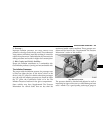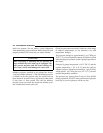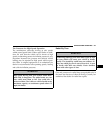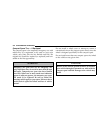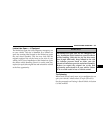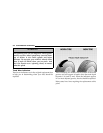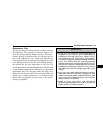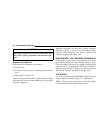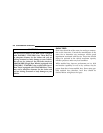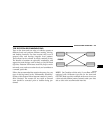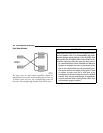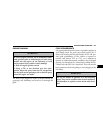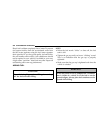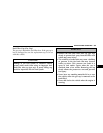
CAUTION!
To avoid damage to your vehicle, tires or chains, observe the
following precautions:
• Because of limited chain clearance between tires and other
suspension components, it is important that only chains in
good condition are used. Broken chains can cause serious
vehicle damage. Stop the vehicle immediately if noise
occurs that could suggest chain breakage. Remove the
damaged parts of the chain before further use.
• Install chains as tightly as possible and then retighten after
driving about 1/2 mile (0.8 km).
• Do not exceed 45 mph (72 km/h).
• Drive cautiously and avoid severe turns and large bumps,
especially with a loaded vehicle.
• Do not install tire chains on front wheels of 4x2 vehicles.
• Do not drive for a prolonged period on dry pavement.
• Observe the tire chain manufacturer’s instructions on
method of installation, operating speed, and conditions for
usage. Always use the lower suggested operating speed of
the chain manufacturer if different than the speed recom-
mended by the manufacturer.
These cautions apply to all chain traction devices, includ-
ing link and cable (radial) chains.
Tire chain use is permitted only on the rear tires of Ram
4X2 trucks.
NOTE: The use of class “U” chains is permitted on the
front and rear of 4X4, 2500 Ram Trucks with LT245/
70R17E tires.
NOTE: The use of class “U” chains is permitted on the
front and rear of 4X4, 3500 Ram Trucks with Dual Rear
Wheels and LT235/80R17E tires.
NOTE: On 4X2 2500/3500 Ram Trucks, class “U” snow
chains are permitted on the rear wheels only of vehicles
equipped with LT245/70R17, LT265/70R17, and LT235/
80R17 size tires.
NOTE: On 4X4 2500/3500 Single Rear Wheel (SRW)
Ram Trucks, class “U” snow chains are permitted on the
rear wheels only of vehicles equipped with LT265/70R17.
STARTING AND OPERATING 277
5



